A car’s starter motor is one of those parts that can easily last a lifetime. Since it rarely needs to be replaced, car owners often do not know where is the starter motor located.
Starter motors are typically located below the cylinders, in the middle of the transmission and engine. Several bolts secure them, and two wires run through them.
We begin this article with a brief description of the starter motor and then describe its location. The article will also provide instructions for finding the starter on various vehicles.
Starter Motor Location
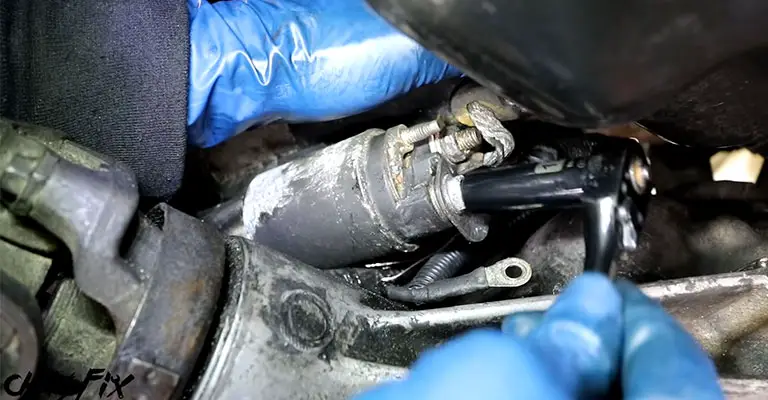
Before we explore the location of the starter motor, let’s briefly discuss what it does. Once you are familiar with the motor, you will have an easier time finding it.
The starter motor, also called a starter, is responsible for rotating (or cranking) internal combustion engines. In doing so, it initiates the engine’s start-up.
When the engine finally fires, the starter motor is no longer connected.
Since starters are electric devices, there are electronic components such as motors and solenoids in them. They usually run on a powerful battery, such as a 12-volt battery.
The sole purpose of a starter motor is to generate enough rotations that an engine needs to start. Other than that, it is almost like an additional burden.
How to Precisely Locate the Starter Motor on Your Vehicle?
Here are five Steps you can follow to locate the starter motor accurately and quickly.
STEP 1: Check for a Clicking Sound
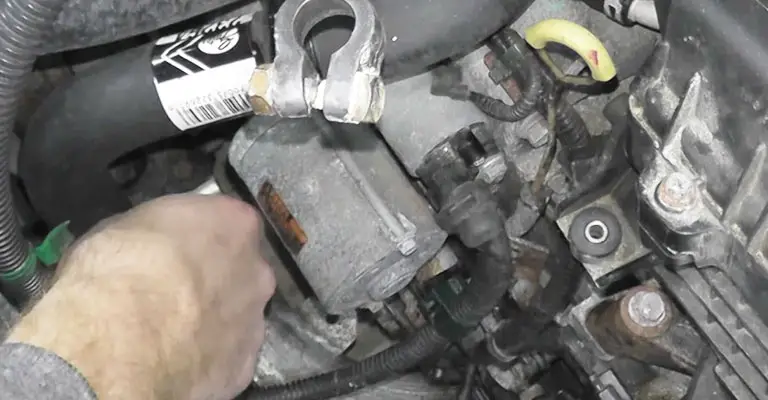
Make sure you have not ignited your car. Pull up the hood. Now that the hood is open, stand nearby and get someone to turn the ignition on.
What you want to do here is listen for a clicking sound from somewhere inside the hood.
STEP 2: Locate the Bolted Cylindrical Part
Once you detect the sound, you should find a bolted cylindrical part near the source of the sound.
Yes, you have successfully figured out the location of the starter motor!
The cylindrical part should be held in place by two or more hex bolts, depending on the model of your car.
STEP 3: Determine Which Terminal Is Positive
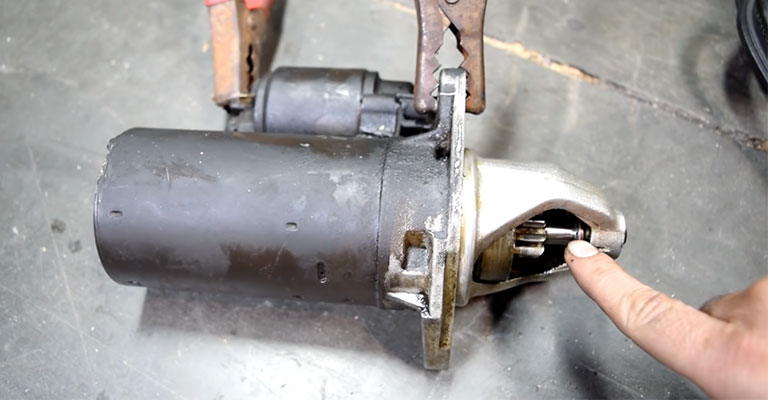
You need to identify the positive terminal of the battery in this Step. If your vehicle is a recently-released model, search for a cable with a plastic cover. This is exactly the cable that leads to the terminal.
When it comes to old car models, the positive terminal is the one with a red wire attached.
STEP 4: Follow the Red Cable
As soon as you discover the red cable, follow it until you get to the end.
The cable connects to one of the starter’s main components. It sits at the edge of the cylinder and is wired to a variety of other electrical systems.
STEP 5: Locate the Starter Motor
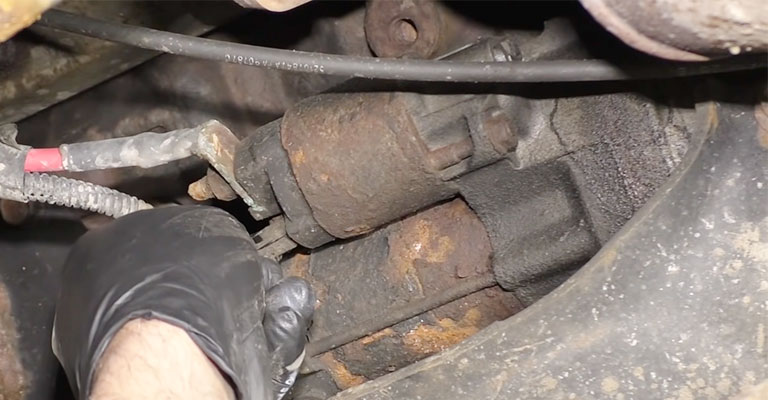
You should notice two components with cylindrical shapes. The larger component is the starter motor, whereas the other is a solenoid.
Starter Motor Locations for Different Cars
Unfortunately, the instructions mentioned above may not apply to all vehicles. Some cars, such as Honda Civic, Ford Taurus, and Chrysler Cirrus, have different starter locations.
Let’s find out where you can find starter motors in these vehicles.
Honda Civic
STEP 1: Open the Hood
Open the hood of your Civic, and you will see a big battery that is usually uncovered.
STEP 2: Jack up the Front
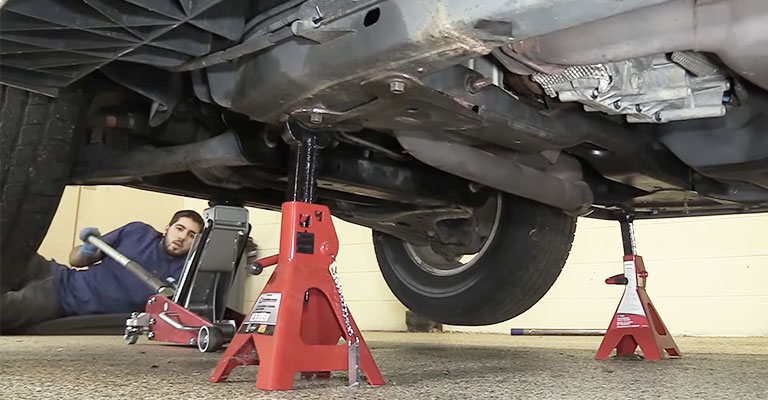
Now raise the front of your vehicle so you can access its bottom.
STEP 3: Follow the Black Terminal Wire
After jacking your car up, take a close look at the battery. You will notice two terminals connected to it, one black and one red.
Make sure you follow the wire of the black terminal. It will take you to the starter motor underneath the engine.
The starter should measure six inches long in case you have trouble identifying it.
Ford Taurus
Latest Generation Ford Taurus
The new Ford Taurus models’ starter motors are protected by a plastic splash shield. You must take it off to access the motor.
Fourth Generation Ford Taurus
You need to inspect the engine’s front side for Ford Taurus models from the fourth generation. The starter and radiator should be in close proximity.
Older Ford Taurus
If your Taurus belongs to the first to the third generation, it would have the starter motor next to the firewall behind the engine.
Chrysler Cirrus
2.5L Cirrus
STEP 1: Lift Your Car
The 2.5L Cirrus mounts its starter motor adjacent to the oil filter. Hence, you need to jack up your automobile beforehand.
STEP 2: Remove the Oil Filter and Exhaust Pipe Bolts
You should then take off the oil filter and loosen all the bolts that join the exhaust pipe to the exhaust manifold.
When all these parts have been detached, it should be easy to remove the starter motor.
2.4L Cirrus
STEP 1: Raise the Car
Once again, jacking the car is necessary since the starter can only be accessed from below.
STEP 2: Unscrew the TCM
Get rid of all the bolts securing the TCM. This way, you will be able to remove the air inlet resonator from the top.
STEP 3: Detach the Transaxle
After that, you must unscrew the bolt connecting the starter and transaxle. And there it is; your starter motor has been removed!
Why Starter Motor Fails?
A starter motor can fail primarily for three reasons. Follow us to see them below.
Faulty Solenoid
You are probably aware of the solenoid switch inside the starter. Sometimes it becomes too stiff, which prevents the starter motor from functioning.
Moreover, if the starter has been in use for a long time, chances are it has developed an entirely faulty solenoid switch.
Defective Single-pinion Gear
Apart from the solenoid, single-pinion gear and freewheel are also part of the starter. If either of these is damaged, the device will not work.
Poor Electrical Connections
The starter motor does not always fail due to its fault. There is also a possibility that faulty electrical connections are to blame.
Furthermore, these motors cannot operate if the power supply is insufficient.
Frequently Asked Questions
- What are the signs of a starter motor problem?
When there is an issue with the starter motor, it is common to hear whirring or buzzing noises coming from the vehicle. You may also experience a loud clicking noise if the starter is malfunctioning.
- Can I replace a starter motor myself?
It is relatively easy to replace starter motors on your own as you only need to unscrew a few components.
However, depending on the car model, you might have to take a lot of things out to replace the motor. In that case, it would be necessary to seek expert assistance.
Final Words
Although it might seem complicated, locating the starting motor is relatively easy, even for a beginner with the right instructions.
Some manufacturers even include diagrams to help you locate the starter motor. Even if there was no diagram with your car, you could simply follow this article to find the starter quickly.
Leave a Reply